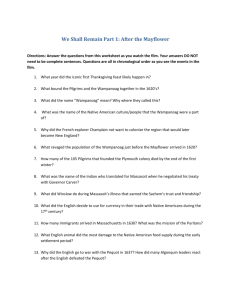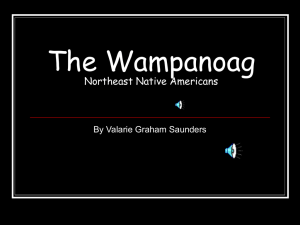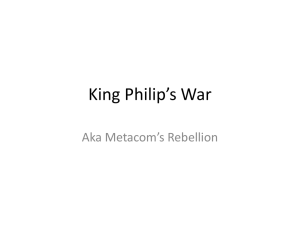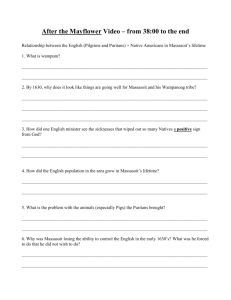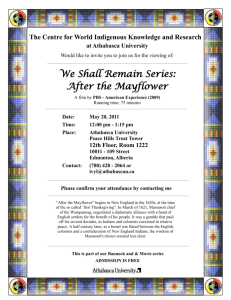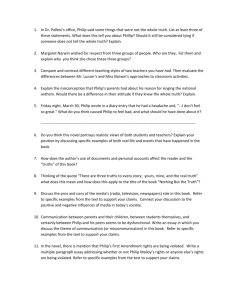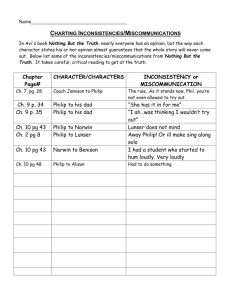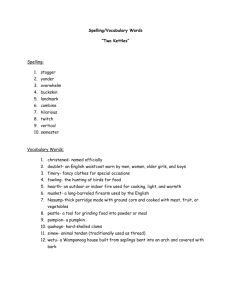After The Mayflower - Leleua Loupe
advertisement
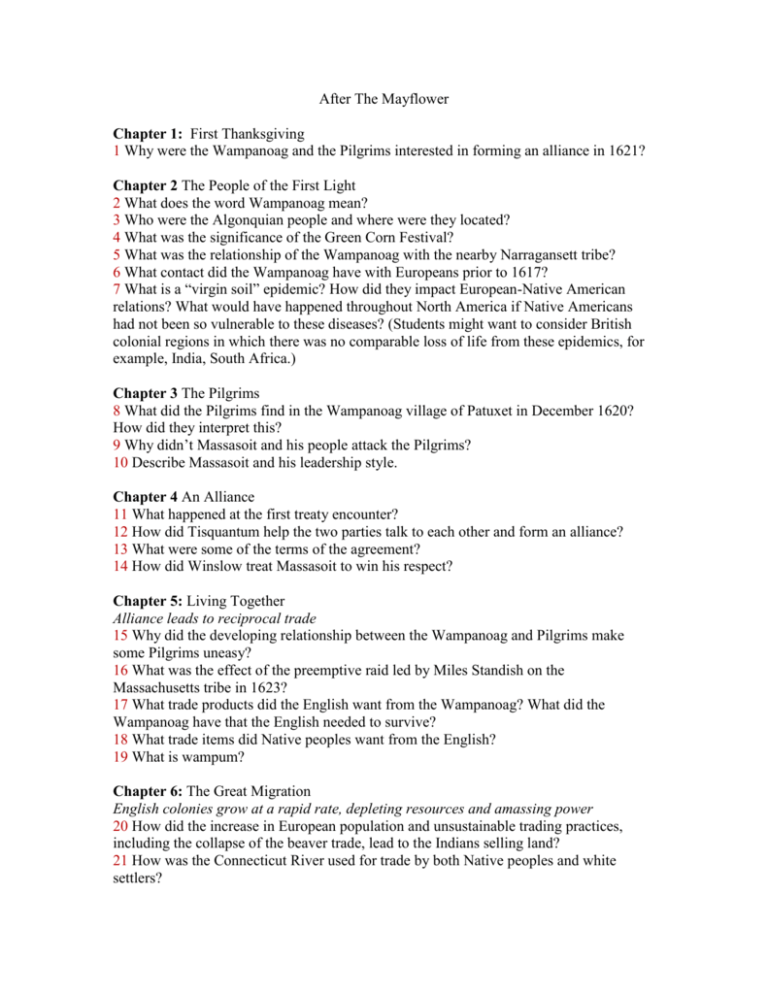
After The Mayflower Chapter 1: First Thanksgiving 1 Why were the Wampanoag and the Pilgrims interested in forming an alliance in 1621? Chapter 2 The People of the First Light 2 What does the word Wampanoag mean? 3 Who were the Algonquian people and where were they located? 4 What was the significance of the Green Corn Festival? 5 What was the relationship of the Wampanoag with the nearby Narragansett tribe? 6 What contact did the Wampanoag have with Europeans prior to 1617? 7 What is a “virgin soil” epidemic? How did they impact European-Native American relations? What would have happened throughout North America if Native Americans had not been so vulnerable to these diseases? (Students might want to consider British colonial regions in which there was no comparable loss of life from these epidemics, for example, India, South Africa.) Chapter 3 The Pilgrims 8 What did the Pilgrims find in the Wampanoag village of Patuxet in December 1620? How did they interpret this? 9 Why didn’t Massasoit and his people attack the Pilgrims? 10 Describe Massasoit and his leadership style. Chapter 4 An Alliance 11 What happened at the first treaty encounter? 12 How did Tisquantum help the two parties talk to each other and form an alliance? 13 What were some of the terms of the agreement? 14 How did Winslow treat Massasoit to win his respect? Chapter 5: Living Together Alliance leads to reciprocal trade 15 Why did the developing relationship between the Wampanoag and Pilgrims make some Pilgrims uneasy? 16 What was the effect of the preemptive raid led by Miles Standish on the Massachusetts tribe in 1623? 17 What trade products did the English want from the Wampanoag? What did the Wampanoag have that the English needed to survive? 18 What trade items did Native peoples want from the English? 19 What is wampum? Chapter 6: The Great Migration English colonies grow at a rapid rate, depleting resources and amassing power 20 How did the increase in European population and unsustainable trading practices, including the collapse of the beaver trade, lead to the Indians selling land? 21 How was the Connecticut River used for trade by both Native peoples and white settlers? 22 What was the outcome of the Pequot War? How did this affect the actions of Massasoit and other Indian groups in the area? Chapter 7:Dispossession 23 Why did the new generation of Plymouth leaders treat Massasoit’s son differently than their fathers had treated Massasoit? How did this treatment differ? 24 What did Massasoit do to protect the culture of the Wampanoag people? 25 What were the praying towns? Why did Massasoit and Philip mistrust the missionaries and their efforts? 26 Describe an underhanded way in which the English claimed possession of Native lands. Chapter 8: King Philip’s War 27 Why did the English authorities summon Philip to Taunton in 1671? 28 What were some of the causes of King Philip’s War? How did the early victories of the Native peoples in this war affect the English colonists? 29 Why were Native Americans relatively successful in the initial months of the war? Chapter 9: The War’s End 30 What turned the tide in favor of the English during King Philip’s War? 31 Philip’s head was left on a pole at Plymouth for two decades. What did that symbolize to the English? Comprehension Questions 1 What events in England caused the Puritans to embark on the largest single human migration of its kind in the 17th century? 2 How would you describe Native economies prior to European contact? Was the concept of wealth used in Native cultures? 3 How did sachems govern their people and how was this different from the structure of European government? 4 By 1662, there were twice as many colonists as Native peoples in New England. Puritans had little regard for the laws and customs of sovereign Indian tribes and began vigorously to impose their own. How did this effect the tribes? 5 Examine the relationship between Edward Winslow and Massasoit. How might this relationship have helped the survival of Plymouth Colony? (You may wish to review Chapter 4, An Alliance) 6 What trading arrangements existed among Native peoples and Europeans? Why was control of the Connecticut River trade so important? How did trade with the Dutch and English cause conflict among the local sachems? 7 What caused the Pequot War? Could it have been avoided? How did the outcome of events at Fort Mystic affect the Wampanoag relationship with the English settlers? 8 What effect did Christian missionaries have on Philip’s decision to go to war against the Massachusetts colonists? 9 Three Wampanoag accused of killing Christian Indian John Sassaman were executed in Plymouth. Why did this force Philip’s hand? 10 Why did Deputy Governor John Easton of Rhode Island try to warn Philip against war? What was the history of Native-European relations in the Rhode Island area? 11 Why might Philip have thought the English settlements would not band together against him? What issues united the different English settlements? 12 What was the lost opportunity of the first Thanksgiving? Discussion Questions 1 Why did Europeans come to the New World? Why did they feel that land was there for the taking? How did they justify their expansion? 2 How did generational differences between white settlers and Wampanoag affect the outcome of colonization? Examine the differences between Massasoit and his son, Philip, as well as Edward Winslow and his son, Josiah. 3 How did the combination of disease, environmental imbalance, and new trading opportunities change Native communities? How did they adapt to survive? 4 Why did Philip take a stand to fight a war even though he had been warned about its potential devastation? What caused such high casualties on both sides of King Philip’s War? 5 Why do you think some Native people who converted to Christianity chose to fight with the English? Why didn’t tribes join together in fighting the English? 6 Was conversion to Christianity the same thing among Native Americans as among Europeans? Were Native Americans converted in a European sense? 7 Do you think the concept of religious damnation was alien to Native peoples? How do we know what tribes of this era believed?
